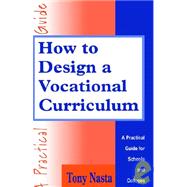How to Design the Vocational Curriculum : A Practical Guide for Schools and Colleges
, by Nasta, Tony- ISBN: 9780749411121 | 0749411120
- Cover: Nonspecific Binding
- Copyright: 5/1/1994
The vocational curriculum is currently under scrutiny and of close interest to government, employers and educationalists. All have drawn attention to the vital importance of increasing participation rates in post-compulsory education in the UK. Neither full-time students staying on beyond 16 nor the increasing number of adult students are likely to have their learning needs satisfied through the academic route alone.
The eight chapters in this book have been written to provide practical help to curriculum designers in schools and colleges currently developing vocational courses. There is detailed explanation and evaluation of important processes, including the preparation of submissions for validation, the designing of flexible learning programmes, the assessment of competence and core skills, the implementation of credit accumulation and transfer, the accreditation of prior learning, and the developing of franchising and quality control.
All curriculum designers are aware of the important implications of the development of NVQs and GNVQs for vocational education. As well as providing practical guidance on how to design and assess outcome-based programmes, this book also relates NVQs and GNVQs to the broader educational principles which inform good practice. Intended for staff in schools and colleges grappling with the complex problem of designing and implementing a vocational curriculum, it will also be of great use to students preparing for a career which involves teaching the post-14 age group.
The eight chapters in this book have been written to provide practical help to curriculum designers in schools and colleges currently developing vocational courses. There is detailed explanation and evaluation of important processes, including the preparation of submissions for validation, the designing of flexible learning programmes, the assessment of competence and core skills, the implementation of credit accumulation and transfer, the accreditation of prior learning, and the developing of franchising and quality control.
All curriculum designers are aware of the important implications of the development of NVQs and GNVQs for vocational education. As well as providing practical guidance on how to design and assess outcome-based programmes, this book also relates NVQs and GNVQs to the broader educational principles which inform good practice. Intended for staff in schools and colleges grappling with the complex problem of designing and implementing a vocational curriculum, it will also be of great use to students preparing for a career which involves teaching the post-14 age group.






